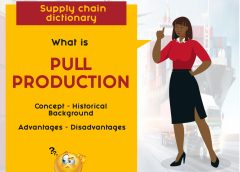Pull production is a manufacturing method that involves producing goods or services only in response to actual demand. This demand can come from an end customer, a distributor, or another player in the supply chain.
What is Pull Production? In pull production, production stages are not initiated in advance but only when demand justifies it. This helps avoid the production of unnecessary stocks, which can lead to storage, transportation, and product depreciation costs.
To operate, pull production relies on several fundamental principles:
- Demand drives production: It is the customer’s demand that triggers the production of the product or service.
- Production in small quantities: This helps limit stocks and respond quickly to demand fluctuations.
- Synchronized production: Different production stages are coordinated to ensure the product or service is available at the right time.
Examples of Pull Production: Pull production is used in various industries, including:
- Automotive Industry: Car manufacturers use pull production to make custom cars based on customer orders.
- Electronics Industry: Electronics manufacturers use pull production to produce electronic products on demand, depending on demand fluctuations.
- Restaurants: Restaurants use pull production to prepare dishes on order, based on customer demand.
History of Pull Production: The principles of pull production were developed in Japan in the 1950s by Taiichi Ohno, one of the founders of the Toyota Production System. This system, also known as just-in-time, is based on pull production to optimize production and the supply chain.
Pull production has since been adopted by numerous companies worldwide and is now considered one of the most effective production methods.
Advantages of Pull Production: Pull production offers numerous advantages, including:
- Stock reduction: Pull production reduces raw material, semi-finished, and finished product stocks, lowering storage, transportation, and product depreciation costs.
- Improved customer satisfaction: Pull production enables quicker responses to customer demands, enhancing satisfaction.
- Increased productivity: Pull production improves resource productivity by avoiding waste.
Disadvantages of Pull Production: Despite its advantages, pull production has some drawbacks, such as:
- Increased complexity: Pull production requires more complex coordination of different production stages.
- Greater supplier dependence: Pull production requires greater supplier reliability as products are manufactured only in response to demand.
To sum up, pull production is an efficient production method with numerous advantages. However, it demands effective coordination of production stages and supplier reliability.






